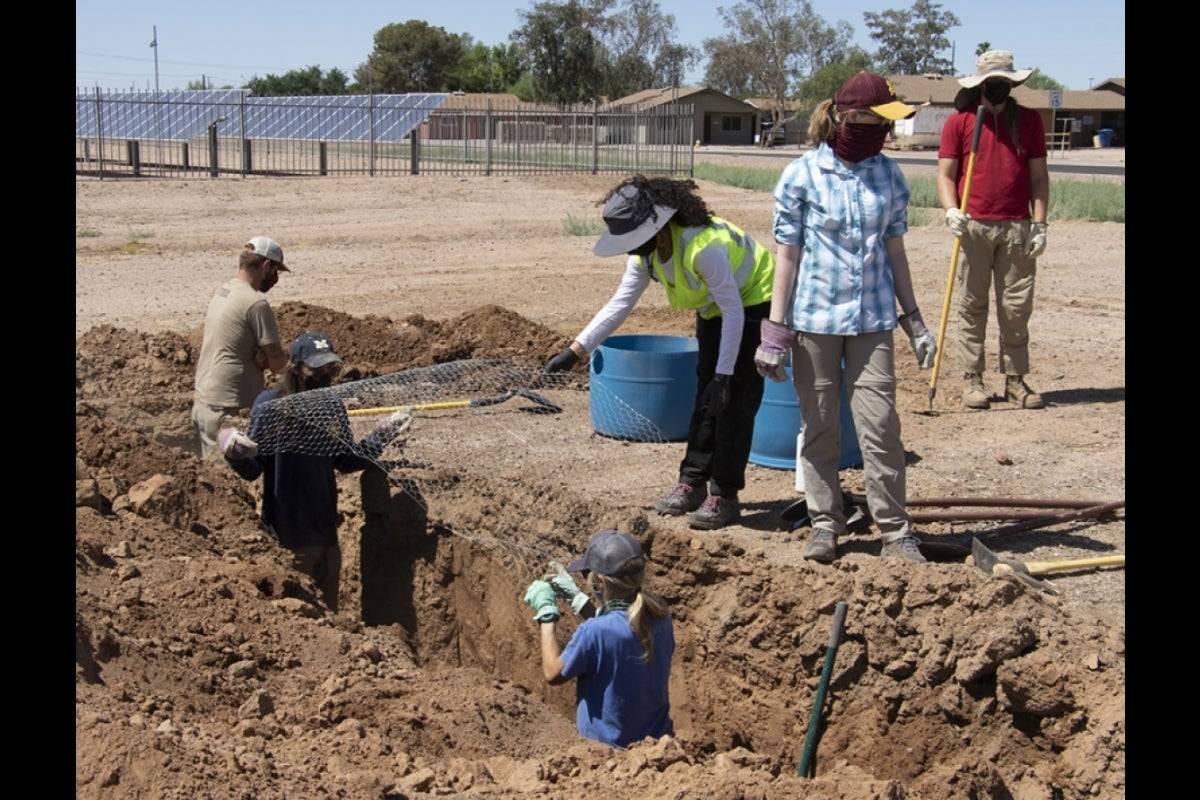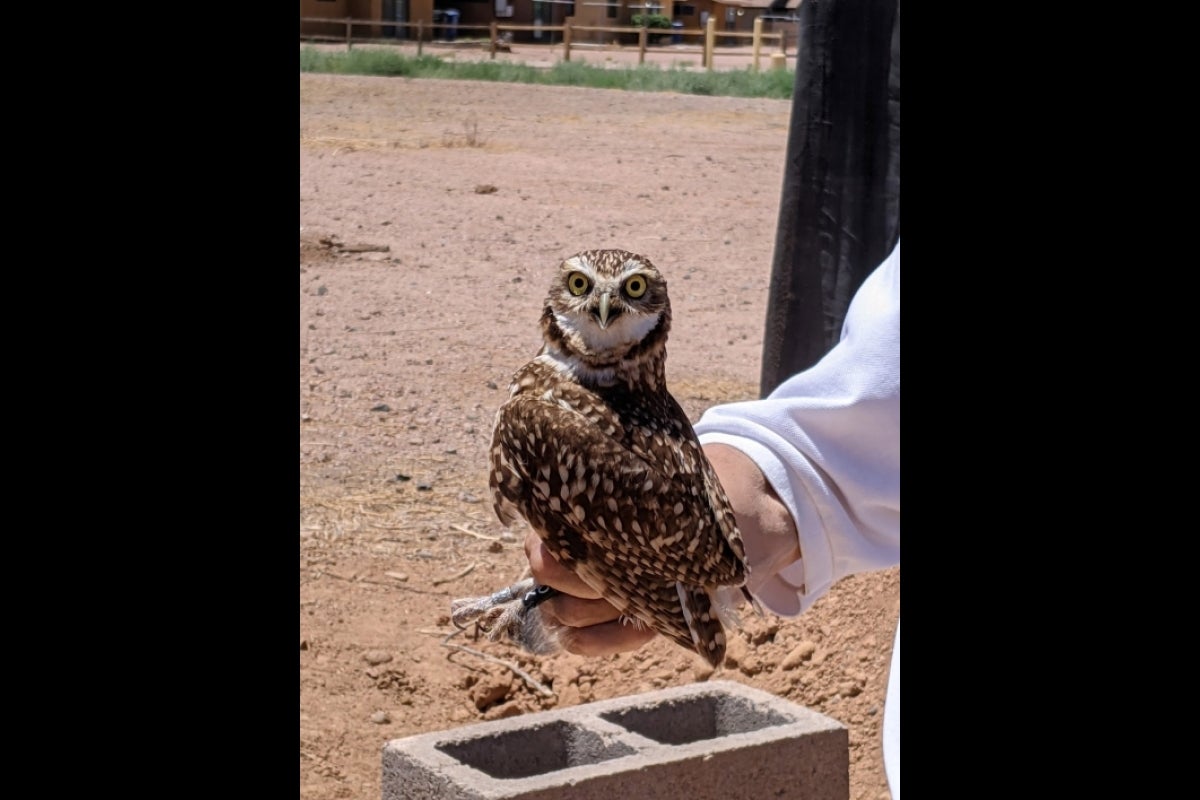ASU Polytechnic campus has rolled out the welcome mat for several distinguished — and feathered — guests: four burrowing owls.
Their arrival in towel-covered cardboard pet-carriers mid-morning on May 22, 2021, was a year in the making and the finishing touches on their burrows — dug out with backhoes and constructed 24 hours before — had just been completed.
In a partnership with Wild at Heart raptor rescue, ASU College of Integrative Sciences and Arts faculty, students, alumni and staff, with the help of ASU Facilities Management staff, have built and will monitor habitats for burrowing owl pairs who need relocating.
“Burrowing owls are native to the Sonoran Desert and the only owls in the world that nest in the ground,” said wildlife ecologist Heather Bateman, associate professor in the college's Faculty of Science and Mathematics, who initiated the project proposal with faculty colleagues Adam Stein and Cynthia Sagers. “These owls rely on other species to do their excavating and will nest in burrows dug by prairie dogs, ground squirrels, desert tortoises and other animals.”
Stretching only 9 or 10 inches when fully grown, they have big yellow eyes framed by a fluffy fringe of white eyebrow, and really long legs. Their silhouette looks much like a Russian nesting doll on stilts.
“Eventually, the owls may provide good public engagement opportunities for the community to learn about and appreciate wildlife,” Bateman said.
“Small owls in general are kind of docile and have a short approach distance, so they’re observable,” she continued. “They sit on perches near the ground and are diurnal, meaning they are active during the day. They have fuzzy and curious nestlings that hang out by their burrows. Burrowing owls produce a range of interesting sounds, from cooing and clacking to screaming, and can mimic the sound of other predators, including the rattlesnake.”
“Three of these owls came from the same burrow, most likely from the Buckeye area,” shared Wild at Heart research-habitat technician Jenohn Wrieden, as she talked with volunteers at the Polytechnic campus before slipping one owl under the shade cloth of the new habitat.
Video by Joshua Zito/ASU College of Integrative Sciences and Arts
The fourth owl, named Marathon, had been in rehab several months, wearing a boot to help mend her fractured leg.
Burrowing owls were once the most populous kind of owl in the continental United States but now are in jeopardy and are considered a "species of concern” by the U.S. Fish and Wildlife Service, so may soon need formal conservation interventions.
“With the extermination of the prairie dog populations in the West due to development, disease and land mismanagement, burrowing owl habitats have been greatly reduced,” said Greg Clark, who has overseen the Wild at Heart translocation operations since 2001. “Today, the U.S. burrowing owl population is only about 1% of what it was 150 years ago.”
But thanks to the Migratory Bird Treaty Act and the work of conservationists and citizen scientists, burrowing owls are being carefully extricated from building sites by organizations like Wild at Heart before excavation begins and then relocated to human-made habitats.
“These owls are pretty hardy and can adapt well to urban living,” Bateman said. “You’ll find them living in culverts, below sewer grates, in erodible soil along canals and open areas like agricultural fields, golf courses, and treeless vacant lots, even next to abandoned cars. They need shade and just enough cover from predators.”
But with construction booming in the Valley, hundreds of owls need relocation.
Relocation requires a soft release
How does the relocation work?
Burrowing owls who have lost their natural homes in one part of the Valley are rescued by Wild at Heart and monitored for about a month in aviaries before being translocated to another location across the Valley as appropriate sites become identified and artificial habitats constructed.
“The research tells us that unless the new burrow can be put in 50 to 100 meters away from the original burrow, it’s best to relocate these owls at quite a distance, so they don't try to return to their original, now-unsafe location,” Clark explained, when asked if any of the first owls introduced at ASU Polytechnic campus may have come from the farmland recently developed along Williams Field Road west of campus.
They are placed as breeding pairs in a habitat network designed to mirror what prairie dogs would build, using simple materials: four-inch flexible irrigation hose, chicken wire, plastic whisker ties, rebar, PVC and large plastic buckets halved.
“These human-made habitats offer the owls a choice of tunnels and burrows to make their own and gives them several options to hide from their natural predators,” said Bateman, “such as great horned owls, Cooper's hawks, red-tailed hawks and other large raptors.”
For the first month of translocation, the owls will be tented with cattle shade-cloth above one burrow while they adapt to their new surroundings and begin to associate this new location with food and “home.”
“They can see right through the mesh and enjoy free-flowing air and any rainfall,” Clark said.
College of Integrative Sciences and Arts students, alumni and faculty are feeding, watering and monitoring the owls daily to make sure they are adjusting well to their new habitat. After a month, the shade cloth will be removed and access to all six burrows opened up.
“Supplemental feeding will continue for another week as they begin foraging on their own,” Bateman said. “They’ll be looking for insects, lizards, rodents to eat and may collect mammal dung, say coyote or fox scat, to attract insects.”
It’s then up to the owls to decide if they want to keep this new habitat as their permanent home or look elsewhere.
“About 30% of burrowing owls choose to remain in these new homes,” she noted. “Our students’ observations will be adding to the research to try to determine why that number isn't higher and to learn more about what environmental factors might contribute to a preferred habitat or relocation time.”
Strengthening the 'applied' in applied biological sciences
For students studying applied biological sciences at ASU's Polytechnic campus, the burrowing owl habitats offer yet another addition to a great outdoor classroom in this desert arboretum, which already includes a lizard habitat, a date grove, bee colonies, greenhouses and a community garden.
Senior Gabriella Mada, who will finish her applied biological sciences major with a concentration in natural resource ecology in December and then the master’s degree the following year as an accelerated “4+1” combined BS/MS option, is already looking forward to beginning research on the owls for her applied project.
“My passion is wildlife conservation,” said Mada, who is also completing a minor in sustainability and a certificate in wildlife management. “This project has so many potential angles and is a great opportunity to work directly with animals.”
Mada has been exploring adding elements to the habitat area that could stimulate natural sources for nourishment, “such as drought-tolerant plants or artificial lights that might draw bugs and other kinds of prey,” she said. “And we’ll be using wildlife cameras to see what predators might be lurking. Hopefully, the owls will survive and stay here.”
Two applied biological sciences undergraduate students did an independent project with Stein this last academic year that laid the groundwork for the Polytechnic campus borrowing owl habitat site locations: Caitlin West, who graduated in December 2020, and Tessa Dashney identified six sites for evaluation by the ASU Architect’s Office and Facilities Management.
“It’s pretty exciting to see my work come to life so quickly,” said West, who was one of the first to arrive to help with burrow construction on May 21 and the first volunteer to feed the owls the next evening.
Many ASU students and faculty will be studying the daily life of these sociable owls, in efforts to contribute to greater knowledge about how humans can help this species survive. Possibilities abound on how to integrate the owls into undergraduate labs in courses like habitat management, range restorations and sustainable horticulture.
The Polytechnic campus owl team extended an invitation to faculty at the ASU West campus to join this endeavor and owl habitats are being installed there with Chad Johnson as the faculty lead. Earlier in May, Stein and applied biological sciences May graduate Tyler Obermeit helped Wild at Heart prepare and install a burrowing owl habitat at Mayo Clinic’s Phoenix campus.
The connection with Mayo Clinic was timely and serendipitous, Bateman said.
“Dr. Catherine (Cat) Chong from their Department of Neurology contacted me in January about wanting to take part in a conservation project on the lands surrounding the clinic and hospital that patients and staff could enjoy. The timing was really perfect because we were in the process of establishing the ASU owls,” she said.
“We visited both the clinic and hospital locations and Adam and Tyler — student president of our student chapter of Wildlife Restoration Society of America — took the lead on making the connection with Wild at Heart and suggesting burrowing owls and screech owl nest box additions to their campus,” Bateman said. “They were able to move pretty quickly and installed burrows and owls on May 10. They’re getting ready to take down the release tents now.”
“The sign-up sheet for the month’s feeding schedule at Mayo had filled up within a week,” observed Obermeit, who drove down from his field internship in the White Mountains (where he’s tracking the endangered New Mexico meadow jumping mouse), to help construct the burrows at Polytechnic campus.
Fingers are crossed that these translocated owl pairs and their offspring take to their new homes. Twelve burrows, each with separate entrances, are located in the vacant lots between the Polytechnic campus water tower and the former community school.
“Whether the owls decide to stay is, of course, up to them,” Bateman said. "But we're very excited to be making wildlife conservation field opportunities accessible to all of our students within minutes of our indoor classrooms."
The project offers further proof that ASU is a university that measures itself not by whom we exclude, but by “hoot” we include and how they succeed.
Would you like to help? Wild at Heart is always looking for help digging holes and identifying new burrow sites in niche urban areas of Phoenix, e.g. around commercial buildings or greenbelts, away from tall trees and buildings where predators could perch but near possible food sources (mice and insects). Contact Greg Clark at greg@BTLLCAZ.com or call Wild at Heart at 480-595-5047.
Top photo: Wild at Heart's burrowing owl relocation coordinator Greg Clark introduces one of the first burrowing owls to be translocated from the West Valley to man-made habitats at the ASU Polytechnic campus on May 22, 2021. Photo by Kelley Karnes, ASU College of Integrative Sciences and Arts.
More Science and technology

Real AI solutions helping people now
AI may be everywhere, but its impacts on day-to-day life are more surprising — and beneficial — than you might realize. From scanning thousands of images to prevent crop shortages to creating …

ASU forges strategic partnership to solve the mystery of planet formation
Astronomers have long grappled with the question, “How do planets form?” A new collaboration among Arizona State University, Michigan State University and Lawrence Livermore National Laboratory will…

AI for AZ: ABOR funds new tools for state emergency response
A huge wildfire rages in the wilderness of Arizona’s White Mountains. The blaze scorches asphalt and damages area bridges, causing traffic accidents when residents attempt to evacuate. As hospitals…
















